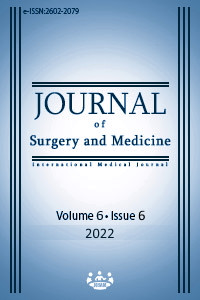Intradural migration of fusion cage in an isthmic listhesis patient treated with transforaminal lumbar interbody fusion (TLIF): A case report
Keywords:
Listhesis, Cage migration, Risk factors, Transforaminal lumbar interbody fusion, TLIF, ComplicationAbstract
Downloads
References
Ishimoto Y, Yoshimura N, Muraki S, Yamada H, Nagata K, Hashizume H, et al. Association of lumbar spondylolisthesis with low back pain and symptomatic lumbar spinal stenosis in a population-based cohort: the Wayakama spine study. Spine (Phila Pa 1976). 2017;42(11):E666–71. doi: 10.1097/BRS.0000000000001960. DOI: https://doi.org/10.1097/BRS.0000000000001960
Liu J, Deng H, Long X, Chen X, Xu R, Liu Z. A comparative study of perioperative complications between transforaminal versus posterior lumbar interbody fusion in degenerative lumbar spondylolisthesis. Eur Spine J. 2016;25(5):1575–80. doi: 10.1007/s00586-015-4086-8. DOI: https://doi.org/10.1007/s00586-015-4086-8
Kayanama M, Hashimoto T, Shigenobu K, Oha F, Ishida T, Yamane S. Non-fusion surgery for degenerative spondylolisthesis using artificial ligament stabilization: surgery indication and clinical results. Spine. 2005;30:588–92. doi: 10.1097/01.brs.0000154766.74637.5e. DOI: https://doi.org/10.1097/01.brs.0000154766.74637.5e
Fan G, Wu X, Yu S, Sun Q, Guan X, Zhang H, et al. Clinical outcomes of posterior lumbar interbody fusion versus minimally invasive transforaminal lumbar interbody fusion in three-level degenerative lumbar stenosis. Biomed Res Int. 2016;2016:9540298. doi: 10.1155/2016/9540298. DOI: https://doi.org/10.1155/2016/9540298
Chrastil J, Patel AA. Complications associated with posterior and transforaminal lumbar interbody fusion. J Am Acad Orthop Surg. 2012;20(5):283–91. doi: 10.5435/JAAOS-20-05-283. DOI: https://doi.org/10.5435/JAAOS-20-05-283
Zhao FD, Yang W, Shan Z, Wang J, Chen HX, Hong ZH, et al. Cage migration after transforaminal lumbar interbody fusion and factors related to it. Orthop Surg. 2012;4(4):227–32. doi: 10.1111/os.12004. DOI: https://doi.org/10.1111/os.12004
Wong AP, Smith ZA, Nixon AT, Lawton CD, Dahdaleh NS, Wong RH, et al. Intraoperative and perioperative complications in minimally invasive transforaminal lumbar interbody fusion: a review of 513 patients. J Neurosurgy Spine. 2015;22(5):487–95. doi: 10.3171/2014.10.SPINE14129. DOI: https://doi.org/10.3171/2014.10.SPINE14129
Aoki Y, Yamagata M, Nakajima F, Ikeda Y, Takahashi K. Posterior migration of fusion cages in degenerative lumbar disease treated with transforaminal lumbar interbody fusion: a report of three cases. Spine (Phila Pa 1976). 2009;34(1):E54–8. doi: 10.1097/BRS.0b013e3181918aae. DOI: https://doi.org/10.1097/BRS.0b013e3181918aae
Hey HW, Hee HT. Open and minimally invasive transforaminal interbody fusion: comparison of intermediate results and complications. Asian Spine J. 2015;9(2):185–93. doi: 10.4184/asj.2015.9.2.185. DOI: https://doi.org/10.4184/asj.2015.9.2.185
Aoki Y, Yamagata M, Nakajima F, Ikeda Y, Shimizu K, Yoshihara M, et al. Examining risk factors of posterior migration of fusion cages following transforaminal lumbar interbody fusion: a possible limitation unilateral pedicle screw fixation. J Neurosurg Spine. 2013;13:381–7. doi: 10.3171/2010.3.SPINE09590. DOI: https://doi.org/10.3171/2010.3.SPINE09590
Smith AJ, Arginteanu M, Moore F, Steinberger A, Camins M. Increased incidence of cage migration and nonunion in instrumented transforaminal lumbar interbody fusion with bioabsorbable cages. J Neurosurg Spine. 2010;13:388–93. doi: 10.3171/2010.3.SPINE09587. DOI: https://doi.org/10.3171/2010.3.SPINE09587
Grant JP, Oxland TR, Dvorak MF. Mapping the structural properties of the lumbosacral vertebral endplates. Spine. 2001;26:271–3. doi: 10.1097/00007632-200104150-00012. DOI: https://doi.org/10.1097/00007632-200104150-00012
Labrom RD, Tan JS, Reilly CW, Tredwell SJ, Fisher CG, Oxland TR. The effect of interbody cage positioning on lumbosacral vertebral endplate failure in compression. Spine (Phila Pa 1976). 2005;30(19):E556–61. doi: 10.1097/01.brs.0000181053.38677.c2. DOI: https://doi.org/10.1097/01.brs.0000181053.38677.c2
Downloads
- 391 569
Published
Issue
Section
How to Cite
License
Copyright (c) 2022 Zahir Kızılay, Murat Özcan Yay, Ahmet Kürşat Kara, Varol Aydın
This work is licensed under a Creative Commons Attribution-NonCommercial-NoDerivatives 4.0 International License.
















